Tiger Beach Sharks…This shallow, sandy area in the Bahamas is firmly established as one of the global diving destinations. With that fame largely derived from the many published images of its most celebrated visitor – Galeocerdo cuvier, the tiger shark.
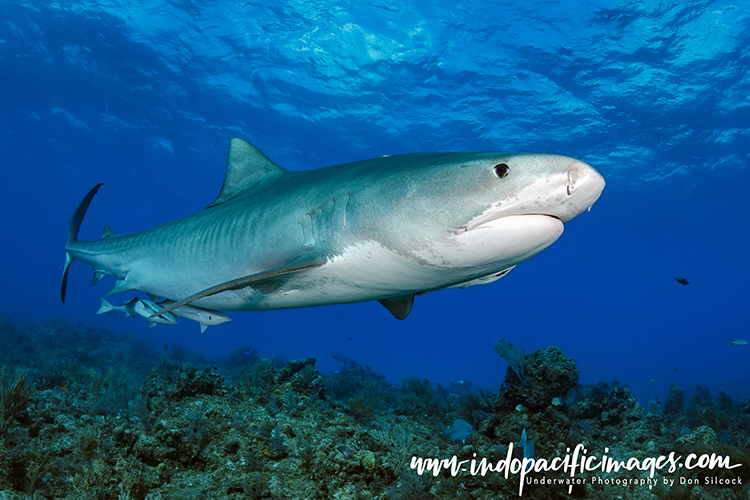
Tigers are considered one of the “big three” most dangerous sharks. And, along with great whites and bull sharks are believed to be responsible for the vast majority of unprovoked attacks on humans.
Renowned for their inherently predatory behavior. Where, much like their terrestrial namesakes, they close in their intended prey slowly and silently before pouncing with deadly efficiency.
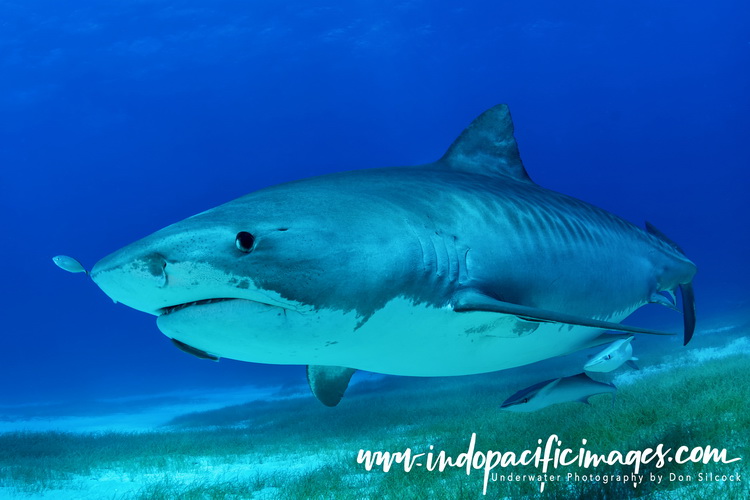
They are also infamous for consuming almost anything and are often referred to as the “garbage cans of the sea”. After inspection of dead tiger’s stomach contents have revealed everything from sheep, goats and even horses to bottles, tyres, license plates and (believe it or not) explosives!
Tiger sharks are one of the ocean’s largest sharks. And typically grow to between 3m and 5m in length and weigh in at around 350kg to 700kg.
They are formidable creatures with an intimidating reputation. So how can it be that week after week in the season, dozens of divers enter the waters of Tiger Beach for open-water, eyeball-to-eyeball encounters?

Tiger Beach Sharks – It Ain’t a Beach…
Physically, Tiger Beach is about a square mile in overall size. It is physically located on the western edge of Little Bahama Bank. About 30km west of the town of West End on the north Bahamian island of Grand Bahama.

And… the first thing you need to know about Tiger Beach is that it isn’t one! It is actually a shallow sand bank that looks like there is a beach nearby.

The general area used to be known locally as Dry Bank. It was first dived by Captain Scott Smith, of the Dolphin Dream liveaboard, back in the late 1980’s. But who actually started the whole shark diving thing is the subject of great discussion!
Scott Smith would seem to be who started tempting sharks in to the back of Dolphin Dream on those early trips. With the first published tiger shark images apparently were captured from the boat.

While the legendary Jim Abernathy, owner of the Shearwater liveaboard, seems to be the person who first took bait boxes into the water in late 2003.
Jim is generally credited with starting the process of tempting tiger sharks in to the bait boxes. And was the person who renamed the area Tiger Beach.
Whoever did what does not really matter now…
What does is that we, as divers and underwater photographers, owe a significant debt of gratitude to Scott Smith and Jim Abernathy for creating what has become the premiere location in the world for tiger shark encounters.
Understanding Tiger Beach
The Bahamas are said to take their name from Baja Mar – Spanish for “shallow seas”. Because the archipelago of 29 main islands and roughly 700 cays that form the country. Reside on top of two main limestone carbonate platforms called the Bahama Banks.
The Great Bahama Bank covers the southern part of the archipelago. While Little Bahama Bank covers the northern part. With incredible channels as deep as 4000m separating the two.
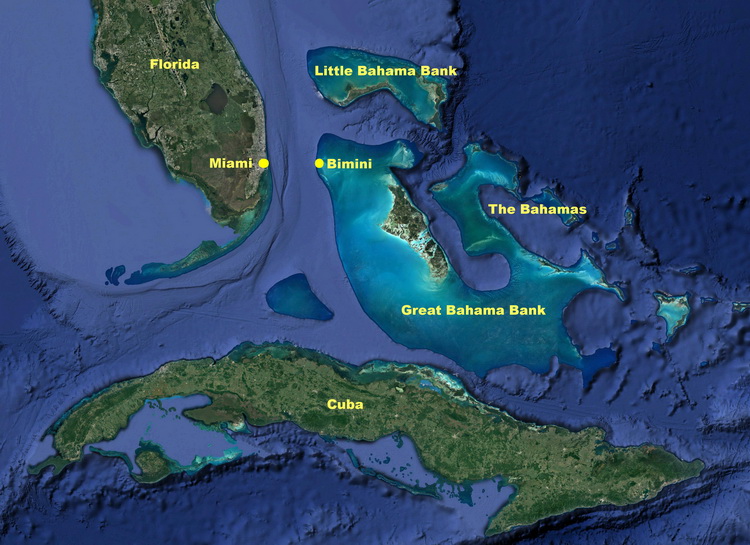
Those channels are flushed with the clean rich waters of the Atlantic Ocean as the Gulf Stream makes its way through the Caribbean and then up the Florida coast. It is the combination of those rich waters and the shallow, sheltered cays and reefs of the Bahama Banks that make the area so prolific.
Tiger Shark Migration
Satellite tagging of tiger sharks in Bermuda has revealed two really interesting facets of their behavior. Firstly they spend a lot of time at the surface. Which is believed to be related to feeding and hunting patterns.
Secondly their migration patterns are very consistent… With 5-6 months of the northern spring and summer months spent in the open Atlantic Ocean to the north and west of Bermuda. Followed by a migration south to the Bahamas where they spend the autumn and winter months.
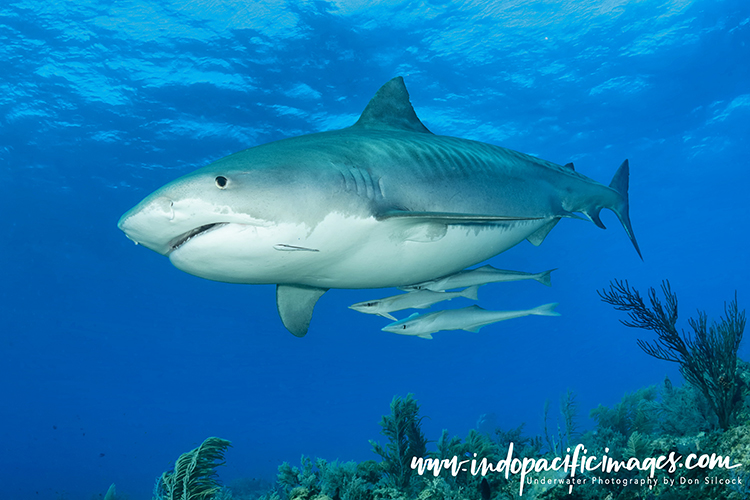
It is believed (but not yet proven) that the months in the open ocean are related to mating. And also feeding on the migratory loggerhead turtles that pass through at that time of year. While the time spent in the Bahamas is related to gestation. As most of the tigers observed at Tiger Beach are females and many of them are pregnant.
Clearly, if the Tiger Beach area is the “tiger shark nursery” it appears to be. It is incredibly important to the long-term conservation of these animals. Which are currently on the IUCN Red List as “Near Threatened” and have a declining population globally.
Conservation in the Bahamas
This island nation in the Atlantic Ocean, famed for its picturesque beauty and crystal-clear waters, has in many ways led the world in marine conservation.
Although far from perfect, and indeed guilty of allowing periodic over-exploitation of its fish stocks. Together with the development of tourist resorts in ecologically sensitive areas. The Bahamas however was the first country to establish a marine protected area (MPA).
That was way back in 1959 when the Bahamas National Trust was established to manage the 112,640 acre Exuma Cays Land & Sea Park. In what can now be considered as an incredible piece of foresight!
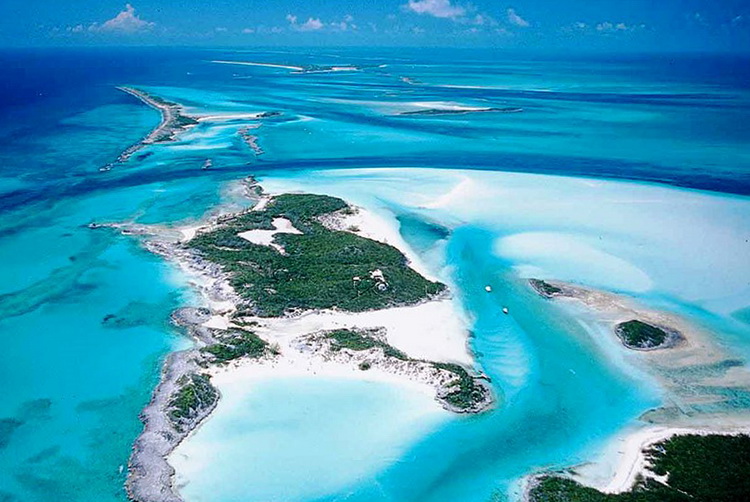
The Bahamas have since added another 26 national parks covering over 1 million acres of land and sea. Together with enacting substantial supporting environmental legislation. Including in 1986 making Exuma Cays a no-take marine reserve.
Then in 2011 the government went one step further. Becoming the 4th country in the world to establish a shark sanctuary. And formally protected all sharks in Bahamian waters.
Shark Tourism in the Bahamas
While establishing the Bahamas as a complete sanctuary was an excellent step forward for shark conservation generally. It was also tacit recognition of the significance of sharks to the overall health of Bahamian fisheries.
The marine environment is a complex and multi-faceted thing. But if there is one global truism it is that everything has its place in the greater scheme of things. And 400 million years of evolution have produced what could be referred to as a “fine balance”.
Sharks are a very necessary part of that balance and can be thought of as the masters of their ecosystems. Their role at the top of the marine food chain is to clean up the oceans with ruthless efficiency. The very thing that seems to most intimidate us humans!
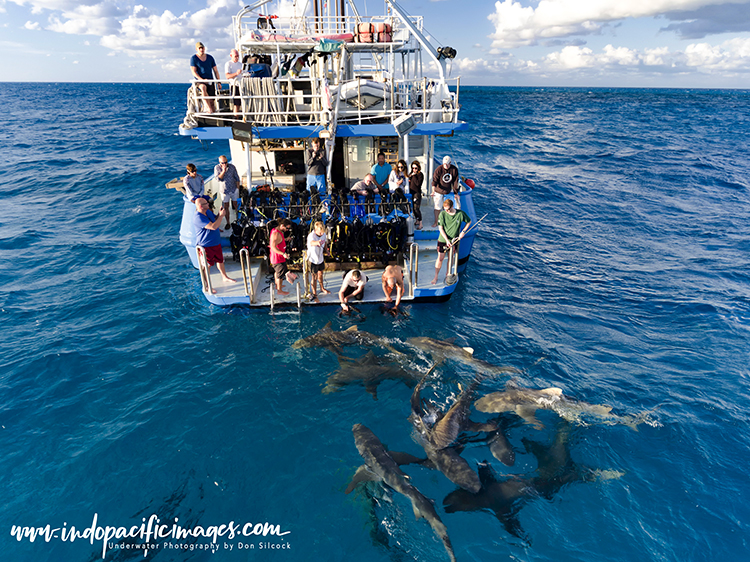
Without sharks the dead, the dying, the diseased and the dumb of the oceans can pollute and degrade the health of those ecosystems and the genetic quality of its inhabitants. The many species of sharks are there for a reason. And they have evolved superbly, in true Darwinian fashion, to execute their mission.
Remove the sharks and disruption occurs, something marine scientists refer to rather prosaically as “trophic cascades”. Think of the shark as the first in a long line of finely balanced dominos and if it is tipped over the rest start to go down as well.
But all that said, there is also the cold hard fact that a live shark is worth a lot more in tourist dollars than a dead one. With one study published in 2017 indicating that 99% of the almost $114m in annual revenue generated by the Bahamas dive industry came from shark tourism.
Tiger Beach Sharks – Briefings…
Arriving for the first time at Tiger Beach is somewhat of a soul-searching experience. Because it’s one thing to read and hear about the sharks that congregate there. But quite another to actually be there preparing for that first dive. Particularly when there are up to a dozen 2-3m sharks circling the back of the boat and lots of others visible in the clear waters!
The briefings provided on these trips are both extensive and exemplary. With everything clearly explained in a logical and non-sensational way. From how to prepare to go in the water, how to enter the water and what to do when under the water.

But the fact of the matter is that waiting for a gap in the patrolling sharks and then carefully rolling in among them is not something you do on a daily basis…
Once underwater however, nerves settle and an awareness starts to form for the sharks and their behavior patterns. From the pushy way the Caribbean reef sharks approach and tend to work in a bit of a pack.To the sneaky way the large lemon sharks come in low to the bottom with a leery look straight out of one of those horror movies.

The Eye of the Tiger!
But that new awareness fades to grey when the first tiger shark arrives. Tigers have an incredibly commanding presence that indicates they know their place at the top of the food chain. They move slowly and carefully. Checking out what is going on and the other sharks clearly defer to them.
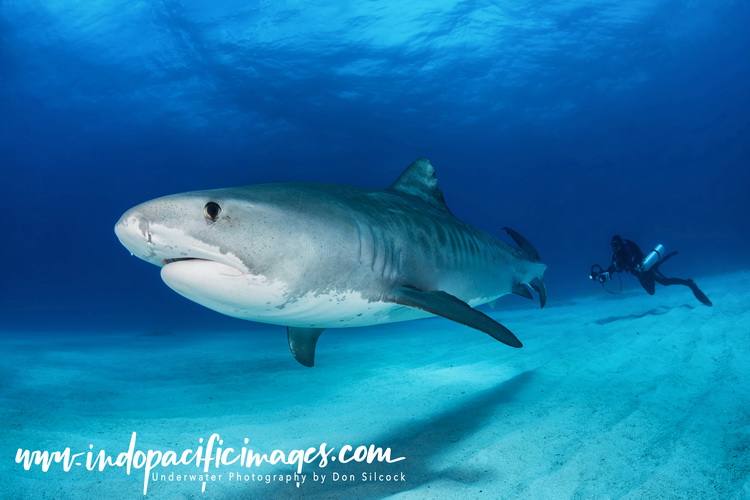
The protocol at Tiger Beach is not to even worry about the lemons and reef sharks. As the only real chance of being bitten is if you break the cardinal rule of getting too close to the bait box. Even then a bite is unlikely to be life-threatening. But you should always know where the tigers are and you should always face them. Literally keeping the eye of the tiger in view at all times!
Tiger sharks are intelligent and curious animals that tend to approach divers because their sensory systems pick up the tiny electrical and audible signals emitted from our instrumentation and photographic equipment.
They will tend to bump with their snouts as they investigate the stimuli further and there is always the chance that will use their mouth and, as their jaws are so powerful, even a gentle nip would be life-threatening.
So, photographers are instructed to use their cameras as a shield, with the strict instruction to let go if a tiger decides to do a taste test – but remember to press the video button…
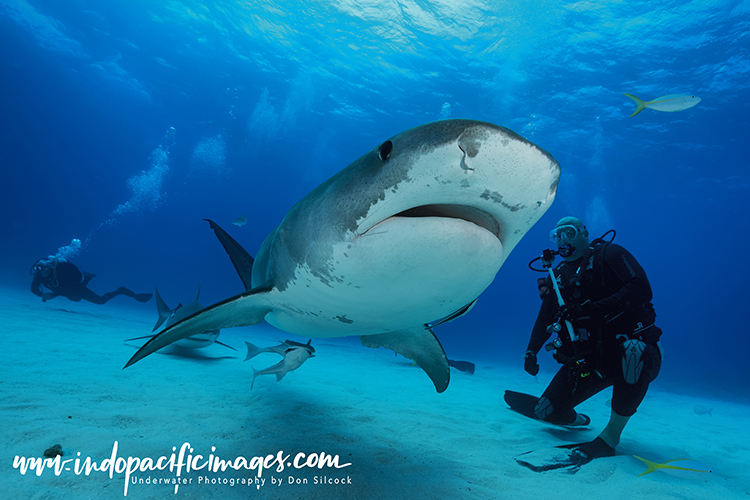
Tiger Beach Sharks – Petting Zoo?
Being in the open-water with so many large and potentially very dangerous sharks’ verges on a life-changing experience. It really is a big deal to be there and the first few days are a kaleidoscope of feelings. Fear, awe, intimidation, excitement and an incredible sense of adventure at what you have done.
Then a degree of complacency starts to settle… As you begin to think that maybe these animals have simply been misunderstood all along. And really they are just kind and gentle creatures…
This for me is when Tiger Beach becomes dangerous. Because you are in a very special place where these creatures are both protected and well fed naturally, plus they get the snacks from the bait box.
So, you are not really seeing them in their natural environment and, in a way yes, it is a kind of petting zoo.

Tiger Beach Sharks – Or the Real Deal?
Tiger Beach is quite unique in that there really us nowhere else like it. Where you can be in the open water in “relative” safety with so many large and potentially dangerous sharks?
The relative in safety comes from the fact that the sharks at Tiger Beach have basically become accustomed to the presence of divers. And, because they have plenty of other things to eat, they do not regard us as a principal food source.
So… while it is absolutely not a completely natural setting. There is simply nothing else like it if you want to see these creatures up-front and personal.
It is the real deal!
X-Ray Magazine Article
This post is part of a nine-page article that was published in the global diving magazine X-Ray. You can use the following link to download Tiger Beach – Petting Zoo or the Real Deal.
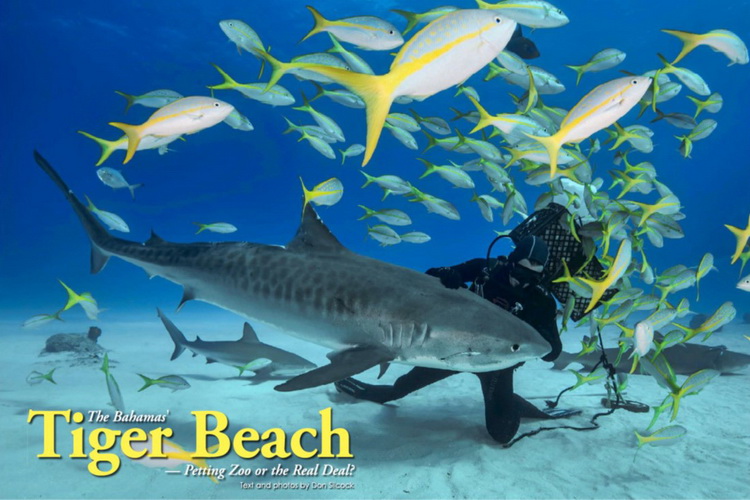
Back To: Exceptional Experiences in the Americas…

